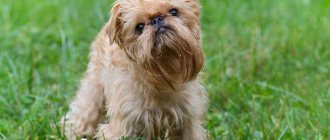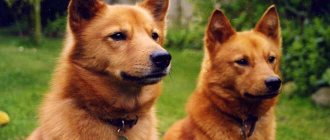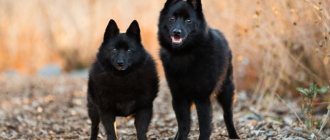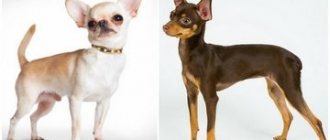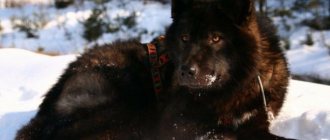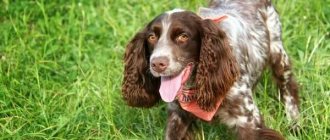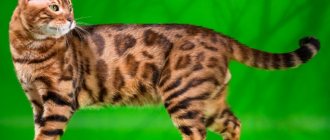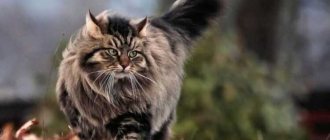The Samoyed Laika or Samoyed is a snow-white, fluffy dog whose homeland is the north. She has natural beauty and a friendly personality.
The dog has light thick fur, black eyes and a proportional build.
Since ancient times, Samoyeds have helped people survive in the harsh conditions of the server. At the same time, they were distinguished by intelligence, endurance and obedience.
Now he is a family dog, an excellent watchman and companion.
In this article we will talk about why Samoyeds are called that, what features they have and who such pets are suitable for.
Short story
The oldest breed of dogs was formed over a long period of time in the harsh conditions of the Russian North. The Samoyed group of tribes settled in the circumpolar regions approximately 4 millennia ago. Nomads who came from the south of Siberia and the Urals, herding deer in the vast expanses of the tundra, became the ancestors of most modern indigenous peoples (Nenets, Enets, Selkups).
From evidence preserved in the ancient Samoyed language, it turned out that already 3 thousand years ago, white fluffy dogs lived side by side with people. The harsh climate and territorial remoteness made it possible to preserve the breed unchanged for a long time (although people did not strive for this).
Most northern tribes used dogs of the same type, which means that many centuries ago people domesticated white wolves, which became the ancestors of Samoyed dogs. Animals were actively used to transport goods over long distances.
They helped people hunt large animals (bears, walruses) and herd herds of deer. On frosty nights, dogs slept with people, warming them with warm fur. Thanks to their patient disposition and responsible attitude towards their duties, they left small children with them without fear.
Researchers from Siberia and the Russian polar zone drew attention to the attractive and hardy animals during their expeditions. The exact version about the ancestors of the modern breed has not been preserved.
There is an opinion that at the turn of the 19th-20th centuries Samoyeds were bred from Nenets Laikas brought from Yamal (among them there are many white individuals). But the generally accepted version of the origin says that the European line came from three animals brought to Great Britain at the end of the 19th century by zoologist E. Kilburn-Scott.
From the first expedition with the researcher to England, a brown male named Sobaka, a white dog named Masti (from the Siberian tribes) and a cream-colored female Whiteley Pechora (from the west of the Urals) arrived.
In 1909, the Samoyed Club was opened in England by Kilburn-Scott and the standard was written down. The charming dog was quickly appreciated by breeders from other countries. The world owes the preservation of the breed and its development to the British. At home, in Russia, it is still only gaining popularity.
Expert opinion
Anna Abramenko
An avid dog lover. Experience in veterinary medicine since 2009.
Ask a Question
In the 1930s, after the Revolution, the number of northern peoples decreased sharply, and with them dogs almost disappeared. Today it is almost impossible to meet a purebred Samoyed preserved in its natural habitat.
History and primary purpose
The northern part of Russia is considered the birthplace of the breed, and the history of its appearance goes back centuries, at least four thousand years.
For many years, Samoyeds (now Nenets) used dogs as their only helpers in the household. They were indispensable guards, charioteers, and hunters. And the most amazing thing is that they are wonderful nannies who warm infants with their bodies. For many years the breed did not leave its range.
The most expensive dogs: photos, breeds, history and features
At the end of the nineteenth century, several copies were exported to Britain. At the same time, the first nursery was organized. After some time, the animals began to gain popularity due to their characteristics.
At the royal court of Edward the Seventh, several Samoyeds were kept.
Breed standards were approved by the British Association in the twentieth year of the twentieth century. Recognition by Europe came a little later. The most offensive thing is that in its native country the population almost disappeared and was forgotten.
The breed came to the Soviet Union from Denmark. Modern society adores these adorable dogs. They can be found all over the world. They have not lost their hunting qualities and instincts.
Why is the breed called this?
Samoyed is a collective name for the peoples who live in the northern latitudes of Russia. The name of the breed presumably comes from the phrase in the ancient Samoyed language “same-edne” (or “land of the Sami”).
Since breeders discovered future purebred dogs in these tribes, the origin of the name is obvious - the animals were named by analogy with the first owners.
origin of name
There are several versions of why this breed is called that.
Some experts believe that the origin of the name comes from the server people living in Russia. In ancient times, the name sounded exactly like that - Samoyeds. The modern name of the nationality is Nenets.
To be more precise, this nation was named from the ancient word “samoyad”, which means “self-contained”, “closed in itself”. This can be understood as the closed way of life of an ethnic group and its closedness from other people.
Another version says that the name comes from the words “sam” and “to go,” since residents of the north often traveled on skis.
There are also versions that the dogs were called Samoyeds because of their color. After all, when they were transporting the team, they were almost invisible in the snow and it seemed that the team was driving itself.
Another option where the name of the breed came from is the expression “saam-jedna”, which means “land inhabited by the Sami”.
NOTE!
The Sami are a small ethnic group of northern peoples living in Norway, Finland and Russia.
Description and standard
The classification places Samoyeds in the same group with Spitz dogs and in the section of northern sled dogs. When running, these animals push powerfully off the ground with their hind legs. Medium size, strong build. At the same time, Samoyeds are light, elegant and graceful.
Adult dog sizes:
- a male weighs between 25-30 kg and grows to 51-56 cm at the withers;
- An adult female has a mass of 17-25 kg and a height of 46-51 cm.
Body proportions: length slightly greater than height, wide and deep chest, strong paws.
Head
The head is wedge-shaped, large, covered with short hair. Stop is expressed.
The breed is divided into 3 types, depending on the shape of the skull:
- bear - the head and ears are rounded, the muzzle is short;
- wolf - the type is similar to the previous one, but the nose is elongated;
- fox - small head, sharp muzzle and ears.
The length of the facial and upper parts of the skull are the same. The eyes are set deep, widely spaced, slightly slanted. The incision is almond-shaped. The color of the iris is dark (brown). Eyelids with black rim.
The distance between the ears is large. The shells themselves are triangular, small, and the cartilage is thick. The nose is only black (in winter it sometimes becomes discolored, but the edging remains). Cheekbones are weakly expressed.
The lips are closed tightly, black. Scissor bite, teeth white and strong.
Expert opinion
Anna Abramenko
An avid dog lover. Experience in veterinary medicine since 2009.
Ask a Question
The limbs are muscular, widely set, straight. The shoulder blades and pasterns are sloped, the shoulders are close to the body. The paws are oval-shaped, the toes are long (protective fur grows between them).
Body type
The neck is medium, with a slight graceful curve. The body is compact. The withers are pronounced.
The back is straight, its length in females is slightly longer than in males. The lower back is narrowed. The croup is wide and has a slight slope. The chest reaches to the elbows. The ribs are round and elastic.
Tail
The tail is set high and carried over the back or side when moving. When at rest it hangs down.
Wool
Samoyeds have long, dense, lush, thick, sparkling hair. It needs to be carefully looked after. Consists of undercoat and a longer, stiffer coat. A “collar” is formed on the shoulders and neck. On the head and limbs the hair length is short. The hair on the outside of the ears is short and smooth, with a good edge on the inside.
The tail and back of the thighs are abundantly covered with thick hair.
Color
According to the standard, three colors are allowed: pure white, biscuit or cream. The main background is always white; there may be a small number of markings on the body.
Any deviations from the listed standards are shortcomings of the breed.
But there are also disqualifying vices:
- multi-colored or blue eyes;
- undershot, undershot;
- excessive timidity or aggression;
- brown or red color;
- floppy ears.
Such individuals are not allowed for breeding or participation in exhibitions.
How to choose a puppy
When choosing a Samoyed puppy, the emphasis is placed depending on what the dog is needed for.
When purchasing a companion dog, the temperament of the pet is especially important. By examining the litter, you can separate the bullies from the calmer individuals. The main thing is that the puppy is not shy or aggressive. Samoyed males have a great desire for leadership and stubbornness. Bitches are more affectionate and sensitive in showing love to their owner.
A future champion can only be acquired with the help of a canine specialist, who will most likely be able to assess the baby’s prospects. His pedigree must include show champions.
A working dog for racing or sports competitions is also purchased based on the characteristics of the parents. At least one of them must have merit in “professional” activities.
Prices for Samoyed dogs are quite high. This is explained by the rarity of the breed, as well as the large costs of maintaining dogs by breeders.
The cost depends on the baby's prospects:
- pet class, which includes purebred pets that do not participate in selection, will cost from 25,000 to 30,000 rubles;
- the breed class is allowed for breeding. Costs up to 40,000 rubles;
- the show class, to which future champions of dog shows belong, costs from 50,000 and above.
The breeder is required to provide a dog passport with information about vaccinations and deworming procedures. The information must be confirmed by the doctor’s signature and the seal of the veterinary clinic.
The Samoyed dog is one of the most beautiful and friendly breeds. Sometimes dogs become hostage to their spectacular appearance. They are kept as pet toys, without thinking about the fact that the wayward and proud companions of nomads require complex care and serious upbringing. Without proper attention, Samoyeds turn into uncontrollable animals with a shattered nervous system. To prevent this from happening, the dog should be provided with proper maintenance. Northern huskies are genetically predisposed to live close to people, sharing their joys and hardships. Faithful companions, reliable friends deserve to be treated with dignity.
Varieties
The first breeder in history, E. Kilburn-Scott, divided his pets according to head shape into fox, wolf and bear types. Unofficially, Samoyeds are still classified this way. There are no other types of the breed.
This is interesting: Popular breeds of bear dogs
Dwarf or mini Samoyeds are common deviations from the standard.
Initially, Samoyeds living in nomadic tribes had quite different colors - black, spotted, brown, beige. Pure white became the standard as a result of the breeding work of early breeders.
Attitude towards children
Throughout the entire existence of the Samoyed breed, they have been considered excellent nannies for children. Because of their balanced, calm nature, they are placed in families with children. But, any contact between a dog and a child should always take place under the supervision of adults, even despite the fact that Samoyeds can freeze in one position so as not to offend the baby.
Samoyed dogs get along equally well with children of different ages. But you shouldn’t let teenagers go for walks together. An overly active Samoyed may become interested in something and pull a child who clearly cannot handle it. As a result, the dog may drop its walking buddy or even run away and get lost.
Character and appearance
Samoyeds are not timid, but they are absolutely not aggressive. They clearly express social behavior. They feel great in the company of people and other animals, they are friendly and cheerful.
They are not wary of strangers and always make contact, which is why they are not good guards. Hunting instincts are weakly expressed (this is a big plus - there will be no encroachments on other domestic animals).
Dogs often show disobedience and stubbornness, and are mischievous. They willingly participate in all family activities and love to relax next to their owners on the sofa. From loneliness they become depressed or start acting out.
Their character is independent, patient, and understanding. Intelligence is high. The pack instinct is developed, so they get along in the company of other dogs. The relationship between the Samoyed and children of any age will be wonderful.
The appearance of the animals is very impressive. They are harmonious, charming and beautiful. And this often becomes the reason for a rash choice of a pet that is difficult to keep.
Character traits
Samoyeds are kind and obedient dogs, always ready to play and have fun. They are always full of life and enthusiasm, friends of children and other pets. Sometimes they are too trusting and friendly, which negatively affects their qualities as guards.
Such pets enjoy spending time with their owner and members of the family. No matter what they do, the dog will always be there.
If you don't give your dog enough attention, he starts to get bored and anxious. Such pets are very susceptible to separation anxiety from their owner, so inattention to them can lead to behavioral disorders. A pet left for a long time may bark, howl, chew things, or shit in inappropriate places for no reason.
Samoyeds are very smart, independent and stubborn, which means they need a firm and principled owner. In addition, they get along well with children and other animals.
As for Samoyed puppies , they can be too active, talkative and annoying. Such traits in a pet remain for approximately 2 years.
Dogs are perfectly adapted to live outdoors and can easily be kept in the yard. They are independent, calm and affectionate, and proper training makes them ideal companions.
It is also worth saying that Samoyeds are quite proud, they love to be the center of attention and willingly participate in any family activities. In addition, they are characterized by curiosity and mischief.
Education and training
Samoyeds, especially at an early age, are not very obedient; training can be a problem at first. For training to be effective, it is necessary to show rigor and introduce variety. Dogs are responsive to praise and encouragement. The right approach will greatly simplify your studies.
You cannot suppress the will of the Samoyed, otherwise he will be stubborn in the future. If you choose the optimal training process from the first months, the dog will quickly become obedient and controllable.
Disobedience and self-will must be nipped in the bud, otherwise a smart Samoyed will immediately sense the weakness and show character. Misdemeanors should be punished, but not too harshly and only fairly.
The pet must immediately recognize the leader in the owner, otherwise the teenager, and then the adult dog, will begin to dominate the family.
Expert opinion
Anna Abramenko
An avid dog lover. Experience in veterinary medicine since 2009.
Ask a Question
In order for living conditions to ideally match the characteristics of the breed, you need to have a country house. Samoyeds are bad guards, so there is no point in putting them in an enclosure or on a chain (this is harmful to the psyche).
Tendency to train
Raising and training Samoyeds is a specific activity, during which it is necessary to take into account that these dogs are pack dogs.
The first thing to start training a puppy with is the hierarchy in the pack.
Once in a family, a Samoyed baby immediately begins to figure out his own role in it. The owner’s task is to define his own leadership and establish rules of behavior. It should not be allowed that some people praise the dog for the same act, while others scold it. The rules must be the same for everyone.
You can teach your puppy simple commands on your own, armed with patience and perseverance. And it is better to delegate more complex tasks to a professional - he will study the temperament and character of the dog, take into account breed inclinations and build a training process.
You cannot shout or hit the dog. The Samoyed reacts very sharply to injustice. But, of course, it is necessary to punish for wrongdoing. To do this, you need to take the dog by the scruff of the neck, lift it, and then press its muzzle to the floor. The Samoyed will not be hurt, but he will understand that he did something wrong.
Care and maintenance of the Samoyed
You should not purchase a puppy earlier than 1.5-2 months of age. And you immediately need to provide the baby with optimal conditions. A private house with a spacious yard is best suited.
If the dog is kept in an apartment, then it will need to organize daily long walks with physical activity (jogging, active ball games, etc.). Regular communication with the owner is necessary; Samoyeds do not tolerate prolonged loneliness.
These dogs do not survive the heat well. They are prone to digging holes in the area, especially in the summer, they remove the heated layer of soil and lie down in a hole.
Traditional rules of care:
- The dog does not have a characteristic odor, its fur is self-cleaning, so the pet should be washed no more than once every 3 months with special products. Frequent bathing with shampoo will make the coat dull.
- Eyes and ears are wiped 2 times a week with a wet cloth.
- Pets are given a personal sleeping area in a cool place, as they are extremely sensitive to overheating.
- Samoyed fur requires careful care. Without weekly brushing, there will be a lot of hair in the apartment, and the dog will take on an unkempt appearance. During shedding, you will have to comb out the fluff every other day.
- Teeth are freed from plaque and stone with raw vegetables, store-bought bones, and cartilage. Cleaning is enough once a week.
- During hot weather, it is advisable to install a bathtub or pool of water in the yard so that the dog can cool down.
Samoyeds are quite difficult to keep and require a lot of attention and love.
Learning ability
Samoyeds were not bred to serve humans, as a guard or service dog. Their purpose was completely different. Therefore, there is no need to require them to strictly follow commands. If this is your first time encountering the breed, then the best solution would be to contact a professional dog handler.
Of course, you won’t get ideal behavior like a German Shepherd, but it’s quite possible to teach basic commands. From the first days of life in a new home, the puppy must be explained the rules of behavior and the limits of what is permitted.
Until full vaccination, you should exercise at home. Initially, you will have to start teaching the animal the name. To do this, you need to call him by name as often as possible. Then he will begin to get used to the leash and collar. They must first be put on for a short time, because... Equipment can be a source of stress for a puppy.
It is important to teach the dog the prohibitive command “no” or “fu”. This will help you avoid eating edible and inedible items outside the home. The command is especially relevant during a walk, when the puppy happily runs after a lying bone.
It is necessary to know the basic commands from the general training course: sit, lie down, stand, towards me, next to me and place.
To have fun with your pet, you can start learning tricks.
Showing teeth and stance is related to show dogs.
Proper nutrition
The owner independently determines the puppy’s diet. When purchasing, it is important to find out what the small dog was fed by the breeder. And then either leave the feeding the same, or gradually transfer her to a new food.
Dry food is required with a high protein content (holistic), or super-premium from a trusted manufacturer.
This is a Useful article: Proven premium food - 2022 rating
The following products should be included in a natural diet:
- at least 30% lean meat (lightly cooked);
- cereals (rice, buckwheat);
- meat;
- sea fish;
- vegetables fruits;
- cottage cheese, kefir.
Completely exclude bones, fatty meats, sweets, baked goods, white bread, potatoes, and beets from the diet. Give limited amounts of pasta, milk, and carrots.
From 1.5-2 to 4 months, meals are 4-5 times a day, then the number of feedings is reduced to 3, by one year - to 2.
Feeding
Good coat condition and the dog's physical activity depend on a properly selected diet. It is easier to feed with specialized foods: ABBA Premium Adult, ProNature Classic, Perfect Fit, Monge Dog Medium.
Natural feeding is more problematic, since not all products are suitable. What to feed the pet is the owner’s choice.
The natural food diet consists of the following products:
- lean meat and offal;
- fermented milk products: kefir, cottage cheese;
- cereals: buckwheat, rice, corn, rolled oats;
- vegetables, any except potatoes and onions;
- fruits and berries.
It is forbidden to give your dog confectionery, baked goods made from wheat flour, smoked and pickled foods, and semi-finished products.
- Puppies are separated from their mother's milk at 1-1.5 months.
- Up to 2 months, the puppy’s diet consists of liquid porridge with milk formula and a small amount of fermented milk products. The puppy should be fed every 3-4 hours.
- From 3 to 4 months, porridge with meat broth and a small amount of lean meat are added to the diet. The number of feedings is reduced to four.
- From 4 to 6 months, the dog is switched to three meals a day. Vegetables and fruits, cartilage and offal are gradually added to the diet.
- From 6 to 8 months, the puppy is transferred to two feedings a day. An adult dog is fed in the morning and evening.
Vitamins are added to the diet of a dog on natural food.
Suitable brands:
- In 1 Excel Deter;
- Beaphar Laveta Super;
- Doctor Zoo;
- Polidex Super wool plus;
- Beaphar Vitamin B Complex.
Health and treatment
The breed was formed naturally, so it has endurance and good health.
Common dog ailments:
- diabetes;
- arthritis;
- joint dysplasia;
- digestive problems;
- genitourinary infections;
- allergies occur periodically;
- rare congenital pathologies - deafness and eye diseases.
The pet's health must be kept under control: vaccinations should be done on time, and regular visits to the veterinarian for examinations should be carried out. If a disease occurs, do not self-medicate, but immediately go to the clinic.
Characteristic diseases
The Samoyed Laika is a hardy and healthy dog.
Typical ailments include:
- Diabetes.
- Bloating.
- Arthritis.
- Infection of the genitourinary system.
- Hip dysplasia.
- Some individuals exhibit sensitivity to analgesics, congenital deafness and eye diseases.
Samoyeds live 10-15 years.
Australian Cattle Dog or Australian Heeler
Australian Kelpie
Australian Terrier
Australian Silky Terrier
REVIEW OF THE 5 BEST FOOD FOR POODLES
MINIATURE BULL TERRIER - IDEAL OPTION FOR AN APARTMENT
CANE CORSO: BREED STANDARD AND APPEARANCE
THE BEST DOG BREEDS
Pros and cons of the breed
The Samoyed's charming appearance often becomes a reason to rashly purchase a dog as an apartment pet. To find out whether the family is ready for such a companion, it is necessary to carefully study the care and maintenance requirements.
Advantages of the breed:
- cheerful, loyal character;
- beautiful appearance;
- no unpleasant odor;
- reverent attitude towards children;
- getting along with other animals.
Obvious disadvantages of the breed:
- beautiful coat requires constant care;
- an energetic dog needs an active lifestyle;
- the animal is not suitable for the role of a guard;
- it loves to bark and howl. This behavior can be somewhat corrected with proper training, but a dog that is bored or has been alone for a long time will most likely begin to vocalize.
Security and guard qualities
The gullibility and friendliness inherent in dogs of this breed put an end to their ability to protect and guard. The maximum that a Samoyed will allow itself towards a stranger is slight distrust. But he definitely won’t scare away with a loud bark and attack a person. There is no aggression at all in this breed. Moreover, at exhibitions, aggressiveness is one of the serious disadvantages.
List of suitable nicknames
When choosing a name for a puppy, follow a few simple rules. The character traits or external signs of the pet are taken as a basis. It is better if the nickname is short (1-2 syllables) and easy to pronounce.
Options for boys:
- Ice, Archie, Arthur, Altai, Agate;
- Bike, Baikal, Bart, Boy, Butch;
- Wulf, Volt, Jack;
- Thunder, Huron, Dick, Watch, Jack, Friend, Zeus;
- Irtysh, Kai, Leo, Loki;
- Marat, Ostap, Prince, Ralph, Rex;
- Frost, Nord, Nils, Scooby, Snowball, Snowdrift;
- Tom, Fog, Umka, Hulk, Charlie, Chip;
- Elf, Ace, Yukon, Yang.
Options for girls:
- Alba, Alpha, Astra;
- Storm, Bonnie, Blizzard, Thunderstorm, Greta;
- Dina, Dora, Gina;
- Winter, Zoya, Kara, Clara, Kira;
- Linda, Lada, Lucy, Molly, Monica, Martha, Mary, Mukha;
- Nora, Nyusha, Polina, Snezhka, Sofia, Sarah;
- Uma, Fiona; Chapa, Ellie, Utah, Yara.
Education is of primary importance in shaping a dog’s character, but it is believed that a nickname can also influence its character and destiny.
Selection rules
A good (and expensive) puppy must fully comply with the description of the breed in the standard and have ideal innate characteristics. Upon purchase, owners are given a veterinary passport with vaccination marks and an RKF card (it is subsequently exchanged for a pedigree).
This is interesting: TOP 10 most expensive dogs in the world
The baby must be kept in good conditions, have no hereditary pathologies and be active and healthy in appearance. The type of breeding for future champions is only linear!
Expert opinion
Anna Abramenko
An avid dog lover. Experience in veterinary medicine since 2009.
Ask a Question
Before purchasing, it won’t hurt to get to know the representatives of the breed closely. You can ask the owner about the difficulties of keeping it. Love and loyalty to the family are guaranteed, but you need to prepare for life under the same roof with an unusual dog in advance.
Mating
It is recommended to breed bitches no earlier than 18 months. When breeding, you should take care to obtain a certificate about the condition of the hip joints. Dogs can be mated between 11 and 14 days from the moment the bitch begins bleeding.
Mating is best done in the male dog's territory. To do this, you will need to pay for the services of an instructor, since due to the increased activity of representatives of the breed, the courtship process is too delayed, against which the moment for mating may be missed.
Samoyed cost
The price of puppies ranges from 12 to 55 thousand rubles. The difference depends on the nursery, producers and region.
The most valuable are those intended for sports (skijoring, bikejoring, cani-cross, etc.). Sled dog racing has gained enormous momentum all over the world, so there is always an increased demand (and even a waiting list) for promising offspring from working parents.
Adult champions and prize-winners of exhibitions are sold for much more - 100 thousand rubles and more.
Nurseries
In Russia, the breed is just gaining popularity, and there are still few reliable nurseries breeding Samoyeds. Therefore, the cost of a puppy suitable for professional sledding is quite high.
If a dog is purchased as a companion, for home keeping, then when purchasing a dog, future owners should pay attention to the reputation of the breeder (or kennel), get acquainted with the manufacturers and their documents.
Where to buy a Samoyed Laika
Before you get a similar breed of dog at home, you first need to decide why you need a dog.
Based on this factor, it is quite easy to select an animal. If you plan to use the dog in exhibition shows, then you should give preference to puppies that meet natural standards. To choose a puppy with excellent external characteristics, you should pay attention to individuals at the age of six months.
To have an ordinary pet at home, it is enough to pay attention to the most affectionate and kind puppies, albeit with minor breed defects.
What to pay attention to
First of all, you should pay attention to the conditions in which the puppies are kept. It doesn’t hurt to see the parent couple, and it is also advisable to inquire about their pedigree. It is imperative to find out whether they have hereditary diseases. When choosing a puppy, you should pay attention to its behavior, its appetite, and its healthy appearance.
Purebred puppies are distinguished by the fact that they have a small head. Small almond-shaped eyes, as well as a relatively short and wide muzzle. The ears are small, triangular and set wide apart. The coat should be clean and shiny, which indicates the health of the puppy. We should not forget that the animal’s fur must be thick and dense, absolutely impermeable to precipitation.
Males should have two fully developed testes (testicles). Each animal must be accompanied by a veterinary passport, which indicates all vaccinations. It is equally important to carefully examine the hind legs. If the puppy's toe has not been removed, then it is not recommended to buy it, since it can later cause serious injuries in an adult animal.
Samoyed Laika price
The most expensive puppies are those used by professionals for sledding sports, such as cany-cross, bike joring, and ski joring. As a rule, such puppies are born exclusively from working pairs of Samoyeds who have either taken part in such competitions or continue to do so.
In our country, such breeding dogs practically do not exist, so they have to be imported from abroad, which is the determining factor influencing the cost of puppies. There is a long waiting list for such puppies with preliminary registrations, since the puppies are the most promising.
The most expensive puppies not only have excellent innate characteristics, but also have:
- RKF puppy cards, in which all data is entered, including the full name of the puppies, their dates of birth, gender and brand number. In addition, the card must contain information about the parent pair and contacts of the breeders. The buyer also fills in the empty fields, indicating his passport details. In this case, each card must have a stamp or seal of the corresponding club or nursery. Subsequently, this document is replaced, indicating the pedigree of the RKF.
- Veterinary passports, which contain all the information about vaccination, as well as the date of deworming.
The purchase and sale agreement can also be considered a binding document. Samoyed puppies one and a half months old are sold at a price of 600-800 dollars. This is due to the fact that in our country there are only 5 nurseries that practice breeding Samoyed huskies. Therefore, you can’t count on low prices.
Interesting facts about the breed
Many interesting facts are known from the long history of the dog’s existence:
- The northern peoples of Russia adapted Samoyeds for carrying heavy loads, but extremely rarely used them for sled riding. Deer were more suitable for this.
- Calling a dog a “Lika Samoyed” is incorrect. However, this version of the name of the breed can be heard quite often.
- The famous writer Jack London once said that this is the most beautiful dog in the world.
- Explorer R. Amudsen was the first to reach the South Pole on a sled with Samoyeds. The breed was incredibly popular in polar expeditions in those days.
- Sometimes you can hear such an erroneous name as “Samoyed Shepherd”.
- Samoyeds, along with Huskies, Chinooks, Malamutes and some other breeds, are leaders in sled dog breeding. A team can cover 50-60 km per day at a speed of 10-12 km per hour.
Due to some external similarity, Samoyeds are called “Arctic Spitz”, although the only thing the two breeds have in common is that they are in the same group of canine classification.
Samoyed dog - a snow-white miracle
One of the oldest breeds that has survived to this day is the Samoyed dog. This is a combination of charm, grace and developed intelligence. Samoyeds attract with their snow-white fur coat and positive smile. We hope our article will be useful not only to those who are already the happy owner of this breed, but also to those who are planning to get themselves a four-legged friend.
Reviews
“We bought a Samoyed solely because of its beautiful appearance and good-natured character. Many other qualities were pleasant surprises: the dog smells almost nothing, eats well and does not suffer from allergies, and during routine cleaning of the apartment there is almost no hair or fluff. The dog picks up commands on the fly and is very obedient. I recommend to all".
“I don’t regret at all that I bought a Samoyed at the time. Jack understands me perfectly, is very attentive and responsive, although he likes to be cunning a little. But I can say for sure: this breed is not for lazy people. It is imperative to regularly groom the dog’s coat, take long walks and pay attention to the dog.”
“I love my Samoyed girl very much. I chose it after much thought, but now I understand that this is not the best option for living in an apartment. The dog needs frequent active walks, which are much easier to organize in a private home. It takes a lot of time. Otherwise, the breed is ideal for a family.”
Basic moments
- The Samoyed is a primitive breed. This means that there was virtually no human intervention in selection, which is why the dogs are in enviable health.
- The Arctic Spitz is an animal accustomed to living in a pack and obeying its laws. This must be taken into account when building a relationship with your pet.
- The Samoyed dog is distinguished by its flexible character, mobility, courage, and friendly attitude towards people and other animals.
- Samoyeds do not tolerate loneliness well. This breed is not suitable for use as a yard dog or chain dog.
- Pamper your pet with fish - unlike other dogs, Samoyeds are very fond of seafood.
- The animal's snow-white fur coat, contrary to popular belief, does not require frequent bathing procedures.
There are 2 types of Samoyed Laikas:
- Bearish - short back, slender build, wide, large head.
- Wolf - lean build, medium-wide chest, wedge-shaped, slightly elongated head.
The Samoyed Laika breed has the following standards:
- The head is powerful with a wide, flat skull. The muzzle is elongated, gradually tapering towards the end. Even lips. With raised corners, which creates the impression of a smile.
- The nose is black, brown or maroon.
- The eyes are slanted, almond-shaped, brown tones of varying intensity.
- The ears are dense, of medium length, moderately rounded at the tips. Set wide apart, fully erect, covered with hair.
- bite . The jaws are powerful.
- The body is of medium length, muscular. The back is straight and wide. The ribs are convex and deep.
- The neck is of medium length, curved, strong.
- Limbs erect, muscular, of medium length. Shoulders are positioned correctly. The shoulder blades are inclined and strong. The hips are wide and muscular. Paws are oval. Fingers are arched, slightly bent.
- The croup is slightly sloping and wide.
- The tail is set high and of medium length.
Disadvantages of the breed:
Disqualifying faults: Light boned.
- Lack of sexual dimorphism.
- The eyes are yellow.
- Convex, barrel-shaped chest.
- Squatness.
- Incorrect placement of limbs.
- Pincer bite.
- Unpigmented lips.
- Blue eye color or different eyes.
- Overshot or undershot.
- Drop ears.
- Cowardice, aggressiveness.
